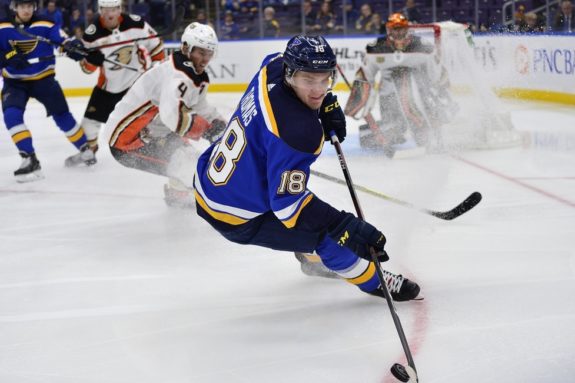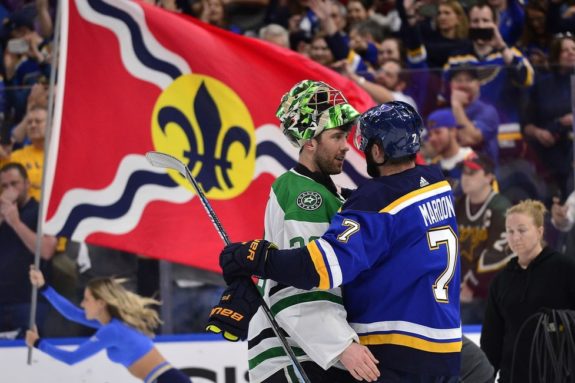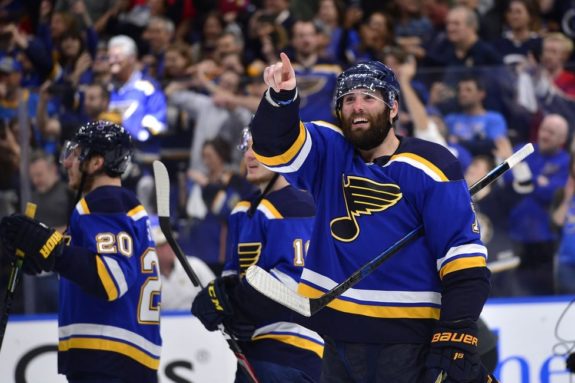Few one-year contracts have had a greater impact or legacy than the one Pat Maroon just officially brought to an end by signing with the Tampa Bay Lightning. The Oakville, Missouri native (a suburb of St. Louis) signed with his hometown team, reunited with his son, and scored the most dramatic goal in a Stanley Cup Championship playoff run.
Now that he is officially leaving home again, many fans are sad to see him go. But the legacy he leaves behind is one that should make all St. Louisans proud to call him one of their own.
A Rocky Start
Just over a year ago, it seemed like Maroon was the last piece in a franchise-altering offseason for the Blues. General manager Doug Armstrong had signed David Perron, Tyler Bozak, and backup goaltender Chad Johnson on July 1. Then, that evening, he traded to acquire Ryan O’Reilly from the Buffalo Sabres. But with Maroon remaining unsigned, many hoped a hometown reunion was quietly in the works, and it came to fruition on July 10.
Unfortunately for Maroon and the Blues, the incredible offseason didn’t yield immediate on-ice results. By now, it’s well known that the Blues were last in the NHL on Jan. 03, 2019, just over six months before they won the Stanley Cup. But Maroon individually was as bad or worse than the team for most of that stretch.
Though he started okay, with six assists in the month of October, Maroon would not score his first goal in a Blues’ sweater until Nov. 24. By Jan. 03, he had just 11 points, only three of them goals, and was a whopping minus-14 on the season. His story was a fitting encapsulation of the Blues’ season up until then: full of hope and excitement, but delivering disappointment.
With the arrival of rookie sensation Jordan Binnington on Jan. 07 (which coincided with the debut of the Blues’ iconic victory anthem, “Gloria” by Laura Branigan), the team began to improve, and the rising tide raised Maroon from the depths as well. Though the points did not immediately improve (he added just five in January and February), he became much less of a defensive liability and stayed a plus-five through those two months.
Thomas, Bozak, and Maroon
While it was Binnington who helped salvage the team’s season, it was another rookie who had the biggest impact on Maroon’s. New head coach Craig Berube paired the St. Louisan with Bozak, the veteran center who had arrived in the offseason, and Robert Thomas, the Blues’ top prospect entering the season. None of the three had quite found traction before that point, but they found it very quickly as a unit.

The trio posted 31 points playing 15 games apiece in the month of March. Maroon led the pack in goals with five, adding another five assists. That helped propel the Blues not only back into the playoff picture, but near the top of the Central Division standings. On the final day of the season, they were still fighting for first place.
Entering the postseason, there was no question that the three had found something that helped all of them individually, and improved the team. They remained a line and contributed significantly through the first two rounds of the playoffs. But it would be the climactic moment of Game 7 in the second round that solidified Maroon’s St. Louis legacy forever.
“Maroon Just Put the City on His Shoulders”
The Blues played a hard-fought series against the Dallas Stars in the second round. Had it not been for the efforts of the Maroon-Bozak-Thomas line, though, even before they scored the deciding goal, the team might never have survived.
They proved to be the Blues’ most important line in Game 3, where Maroon scored the game-winning goal, Thomas added an assist, Bozak had a goal and an assist, and the unit was a combined plus-seven. Thomas would also score his first-ever playoff goal in Game 4, though it was a losing effort. Towards the end of the series, it was clear that he especially was breaking through, and Berube began to double shift him frequently.
Then, in the final game, the Blues needed a hero. Stars’ goalie Ben Bishop, himself a St. Louis native, looked unbeatable, stopping 52 of 53 shots through four periods and five additional minutes. But a faceoff to his left led to one of the greatest moments in Blues history.
Bozak lined up to take the draw, winning it from Roope Hintz. Maroon received the puck and quickly knocked it over to Thomas before moving to clear the lane of Stars defender Miro Heiskanen. Thomas cut through the newly created space and crashed the net, beating Bishop on the glove side, but narrowly scraping the post. The puck fluttered and landed in the crease behind Bishop, where Maroon arrived to clean up the mess and score one of the iconic goals in franchise history.

The hometown, double-overtime, series-clinching, Game 7 goal was the highlight of Maroon’s season, and, likely, his entire career. It propelled the Blues onto the Western Conference Final, where they beat the Sharks in six games. Then, they would capture the Stanley Cup for the very first time, beating the Boston Bruins in seven games.
Maroon only registered two more assists in the playoffs, partly because Thomas began to struggle with an injury early in the series against the Sharks. But he had already played his part. No Blues fan will ever forget the goal he scored, perhaps the greatest in his hometown team’s first-ever Stanley Cup Championship run.
Bon Voyage
Fans wanted to see Maroon return to the Blues, but it seemed clear early in the offseason that he would not. The arrival of Zach Sanford and Sammy Blais as key contributors in the playoffs made extending Maroon a luxury that the Blues, pressed against the salary cap, likely could not afford.
Still, supporters were sad to see Maroon officially bid farewell to his hometown once again by signing with the Lightning. There, he will join the reigning President’s Trophy winners, hoping to provide the grit and playoff experience that can help them avoid another first-round embarrassment in 2020.

Before leaving, Maroon penned a letter to his fellow St. Louisans which he shared on the Blues’ website. In it, he wrote: “This is bittersweet for me. I want to start by saying thank you to the St. Louis Blues organization for giving me a chance to play in my hometown and living out a dream that I had since I was a kid to put on the Blue Note.”
“Thank you,” Maroon continued, “to all the loyal Blues fans who stuck by me even through the bad, you guys are some of the best in the game.” The touching letter made it clear just how much his season in St. Louis had meant to Maroon, and how much the fans meant to him. And without question, that feeling was 100 percent mutual.